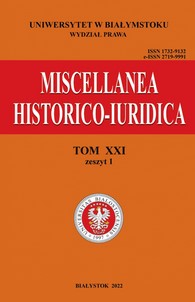Specyfika działalności sejmikowej województwa połockiego
Specifics of the Sejmik Activity of the Polotsk Voivodeship
Author(s): Karol ŁopateckiSubject(s): Military history, Political history, 16th Century, 17th Century, 18th Century
Published by: Wydawnictwo Uniwersytetu w Białymstoku
Keywords: Sejmiks; parliamentarism; Polotsk voivodship; Grand Duchy of Lithuania; sejmik geography; editions of sejmik records; Small Sejm of the Duchy of Polotsk; Polotsk voivods;
Summary/Abstract: The article presents the initial assumptions of the project to publish the sejmik records of the Polotsk voivodeship. The conception of the work, the source basis and the activities of the assemblies of the Polotsk nobility are presented. The territory of the Polotsk voivodeship in the 16th-18th centuries has been approximated and the political features of the Polotsk voivodeship in the 16th–18th centuries have been indicated, emphasising its significance in comparison with other territorial units of the Grand Duchy of Lithuania. To this end, existing knowledge about the province was gathered to show the specifics of the region. In particular, the origins of the modern sejmiks in the Polotczyzna region are presented, including the existence of the „small sejm” before the reforms of 1565–1566. The consequences of the peripheral sejmik, which covered lands long threatened by military aggression, are indicated. Finally, the characteristics of sejmik life in the Polotsk region are highlighted. For these issues, in addition to the analysis of legal acts and sources of sejmic practice, a quantitative analysis was used (Charts 1 and 2) and methods appropriate to historical geography were applied (Maps 1 and 2). The collected data shows the peripherality of Polotsk and, in particular, of the local noble assembly. Firstly, this was due to its low importance in the context of the functioning of the General Sejm or the Lithuanian Tribunal. Secondly, it was an area constantly threatened by military conflicts. This is externalized by the great variability of the places of sejmiks sessions. We can distinguish as many as nine sejmik capitals, besides which at least six other locations are known. This is a record in the recognised areas of the Polish-Lithuanian Commonwealth.
Journal: Miscellanea Historico-Iuridica
- Issue Year: 21/2022
- Issue No: 1
- Page Range: 117-152
- Page Count: 36
- Language: Polish

